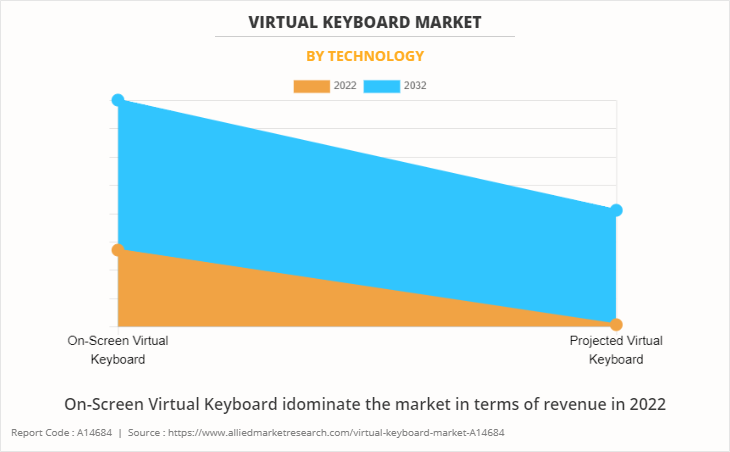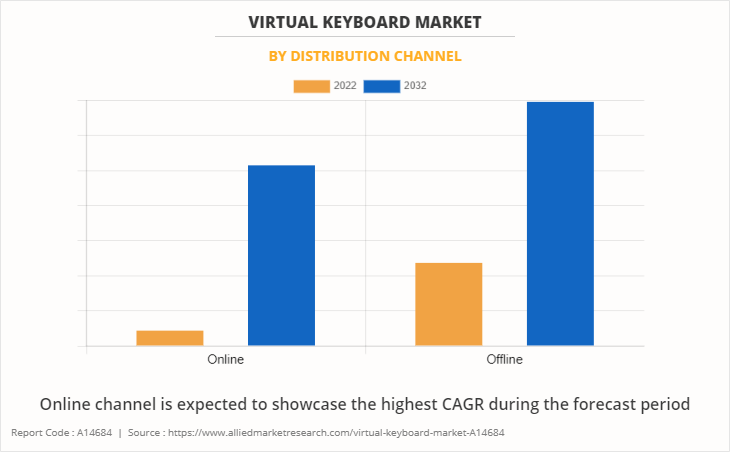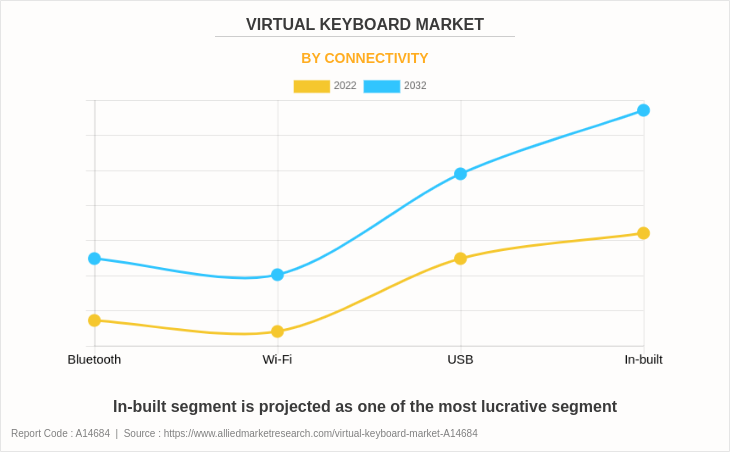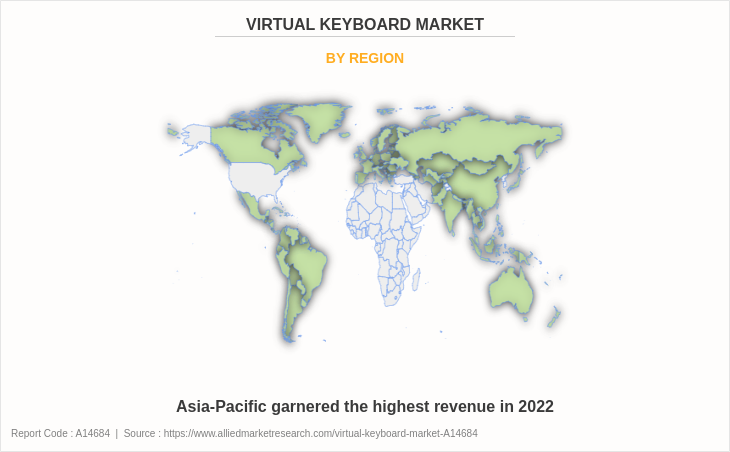Virtual Keyboard Market Research, 2032
The Global Virtual Keyboard Market was valued at $1.1 billion in 2022, and is projected to reach $2 billion by 2032, growing at a CAGR of 6.5% from 2023 to 2032.
A virtual keyboard is a software-based input device that allows users to enter text or commands into a computer or mobile device without the need for a physical keyboard. It typically appears on the device's screen and is operated by touching or clicking on the virtual keys using a mouse, stylus, or fingers. These keyboards are versatile and adaptable, as they can be customized in size, layout, and appearance to suit user preferences.
Virtual keyboards are commonly used on smartphones, tablets, and other touchscreen devices, providing a convenient and space-saving alternative to traditional physical keyboards. They enhance accessibility and usability, catering to diverse input needs and allowing users to interact with digital devices seamlessly.

Segment Overview
The virtual keyboard market is segmented into technology, distribution channels, connectivity, and region.
The virtual keyboard market offers numerous advantages in the realm of computing and technology. It provides enhanced flexibility and adaptability, allowing for diverse input methods across various devices, including smartphones, tablets, and touch-enabled laptops. Virtual keyboards are space-efficient, eliminating the need for physical keys and making them ideal for compact and portable devices. Moreover, they facilitate multilingual input with ease, accommodating global users.

By technology, the market is divided into on-screen keyboards and projected keyboards. In 2022, the on-screen keyboards segment dominates the market in terms of revenue.
Accessibility features, such as resizable keys and customizable layouts, cater to different user needs. In addition, virtual keyboards contribute to improved hygiene by eliminating the risk of physical contamination. Overall, the virtual keyboard market empowers users with versatile and user-friendly input solutions, fostering innovation and efficiency in the evolving landscape of digital interaction.

By distribution channel, the market is classified as online and offline. In 2022, the offline segment acquired the largest share in 2022 and is expected to grow at a significant CAGR from 2023 to 2032.
The most important driver of the virtual keyboard market is the proliferation of touchscreens. With the widespread adoption of smartphones, tablets, and touch-enabled laptops, users increasingly interact with devices through touch interfaces. Virtual keyboards, appearing on the device's screen, align perfectly with this trend, offering an intuitive and user-friendly input method.

By connectivity, the market is bifurcated into Bluetooth, Wi-Fi, USB, and in-built. In 2022, the in-built, segment acquired the largest share 2022 and is expected to grow at a significant CAGR from 2023 to 2032.
The touch-driven nature of these devices fosters the natural evolution and integration of virtual keyboards, as physical keyboards become less practical for compact and portable gadgets. As touchscreens become the norm in consumer electronics, the demand for virtual keyboards continues to rise, solidifying their role as a crucial component in the evolving landscape of digital interaction and input methods.

By region, it is analyzed across North America (the U.S., Canada, and Mexico), Europe (UK, Germany, France, Italy, and the rest of Europe), Asia-Pacific (China, Japan, India, South Korea, and the rest of Asia-Pacific), Latin America (Brazil, Argentina, and the rest of Latin America), and Middle East and Africa (UAE, Saudi Arabia, Qatar, South Africa, and the rest of the Middle East and Africa). The Asia-Pacific virtual keyboard market is expected to grow at the highest CAGR during the forecast period.
Furthermore, the integration of virtual keyboards with emerging technologies, specifically augmented reality (AR) and virtual reality (VR) is a key driver in the virtual keyboard market. Virtual keyboards play a pivotal role in these immersive environments by serving as a user-friendly interface for input within AR and VR applications. In augmented reality, users can interact with virtual keyboards in real-world settings, enhancing their ability to engage with digital content seamlessly. In virtual reality, virtual keyboards provide a practical means of text input when physical keyboards may not be accessible. This integration opens new possibilities for immersive computing experiences, expanding the utility of virtual keyboards beyond traditional devices. As AR and VR technologies continue to advance, the demand for intuitive input methods like virtual keyboards is expected to grow, driving further innovation in this market.
However, security concerns hinder the growth of the virtual keyboard market. The reliance on touchscreen interactions raises apprehensions about the vulnerability of sensitive data input, as virtual keyboards are susceptible to keyloggers that can potentially capture and compromise user inputs. This security risk is particularly pronounced in applications where confidential information, such as passwords or financial data, is entered using virtual keyboards. As cyber threats evolve, ensuring the robust protection of user data becomes crucial for maintaining trust and user adoption. Developers and manufacturers in the virtual keyboard market must prioritize implementing advanced security measures to safeguard against potential breaches and address user concerns about the security of their digital interactions.
Furthermore, the rise in demand for touchscreen devices, particularly smartphones and tablets, offers a significant opportunity for the growth of the virtual keyboard market. With consumers gradually moving towards touch-based interfaces, virtual keyboards have become integral to these devices, providing a software-based solution for text input. The widespread adoption of smartphones has led to a surge in virtual keyboard usage, with touchscreens replacing physical keyboards as the primary means of interaction. This trend is fueled by the desire for sleek, compact device designs and intuitive user experiences. As the global adoption of touchscreen technology continues to grow, the virtual keyboard market stands to benefit from the ongoing proliferation of touch-enabled devices, presenting ample opportunities for innovation and expansion.
The virtual keyboard market is segmented based on technology, connectivity, distribution channel, and region. By technology, the market is divided into on-screen keyboards and projected keyboards. In 2022, the on-screen keyboards segment dominated the market in terms of revenue and is expected to follow the same trends during the forecast period. By connectivity, the market is bifurcated into Bluetooth, Wi-Fi, USB, and in-built. The Wi-Fi segment is expected to grow at a high CAGR during the forecast period. By distribution channel, the market is classified as online and offline. In 2022, the offline segment dominated the market in terms of revenue and is expected to follow the same trend during the forecast period. Moreover, the online segment is expected to grow at a high CAGR during the forecast period.
By region, it is virtual keyboard market segmentation is analyzed across North America (the U.S., Canada, and Mexico), Europe (UK, Germany, France, Italy, and the rest of Europe), Asia-Pacific (China, Japan, India, South Korea, and rest of Asia-Pacific), Latin America (Brazil, Argentina, and Rest of Latin America), and Middle East and Africa (UAE, Saudi Arabia, Qatar, South Africa, and Rest of the Middle East and Africa). Asia-Pacific, specifically China, remains a significant participant in the virtual keyboard industry. Major organizations and government institutions in the Asia-Pacific region have significantly put resources into action to develop enhanced Virtual keyboards, which is driving the growth of the virtual keyboard industry in the region.
Competitive analysis and profiles of the major virtual keyboard companies, such as ABB, Alphabet Inc. (Google LLC), Apple, Fleksy, Swype, TouchPal, Samsung, iNextStation Virtual, CTX Technologies, and ShowMe, are provided in this report. Product launch and acquisition business strategies were adopted by the major market players in 2022.
Country Analysis
In North America, the U.S. holds the largest share of the virtual keyboard market size by country and is expected to grow at a CAGR of 5.16% during the forecast period. Technological advancements, increasing reliance on digital devices, and a growing preference for touch-based interfaces are expected to foster market expansion during the forecasted period.
In Europe, the UK dominated the market in terms of revenue in 2022 and is expected to follow the same trend during the forecast period. Moreover, the UK is one of the fastest-growing countries in the Europe virtual keyboard market, with a CAGR of 6.62%.
In Asia-Pacific, China holds the dominant market share, owing to robust economic growth, technological advancements, and an expansive consumer base. These factors position China as a key player, with sustained dominance expected during the forecast period.
In Latin America, the Rest of Latin America region accounted for the largest market share and is expected to follow the same trend during the forecast period, owing to expanding industries and increasing consumer demand. However, Brazil is expected to emerge as one of the fastest-growing countries in the Latin America virtual keyboard market growth with a CAGR of 8.34%, owing to a rise in tech adoption, digital transformation, and expanding consumer markets.
In the Middle East and Africa, the UAE dominated market share and is expected to follow the same trend during the forecast period, owing to robust economic diversification, strategic investments, and innovation.
Top Impacting Factors
The virtual keyboard market analysis is expected to witness notable growth owing to increasing reliance on mobile devices and the growing trend of remote work. Moreover, continuous technological advancement is expected to provide lucrative opportunities for the growth of the market during the forecast period. However, potential vulnerability to cybersecurity threats limits the growth of the virtual keyboard market report.
Historical Data And Information
The virtual keyboard market share by company is highly competitive, owing to the strong presence of existing vendors. Vendors of virtual keyboards with extensive technical and financial resources are expected to gain a competitive advantage over their competitors because they can cater to market demands. The competitive environment in this market is expected to increase as technological innovations, product extensions, and different strategies adopted by key vendors increase.
Key Benefits For Stakeholders
- This report provides a quantitative analysis of the market segments, current trends, estimations, and dynamics of the Holographic Keyboard market analysis from 2022 to 2032 to identify the prevailing virtual keyboard market opportunity.
- The market research is offered along with information related to key drivers, restraints, and opportunities.
- Porter's five forces analysis highlights the potency of buyers and suppliers to enable stakeholders make profit-oriented business decisions and strengthen their supplier-buyer network.
- In-depth analysis of the virtual keyboard growth projections segmentation assists to determine the prevailing market opportunities.
- Major countries in each region are mapped according to their revenue contribution to the global market.
- Market player positioning facilitates benchmarking and provides a clear understanding of the present position of the market players.
- The report includes the analysis of the regional as well as global virtual keyboard market overview trends, key players, market segments, application areas, and market growth strategies.
Virtual Keyboard Market Report Highlights
| Aspects | Details |
| Market Size By 2032 | USD 2 billion |
| Growth Rate | CAGR of 6.5% |
| Forecast period | 2022 - 2032 |
| Report Pages | 250 |
| By Technology |
|
| By Distribution Channel |
|
| By Connectivity |
|
| By Region |
|
| Key Market Players | TouchPal, Alphabet Inc. (Google LLC), Apple, ABB, Fleksy, ShowMe, iNextStation Virtual, Swype, CTX Technologies, Samsung |
Analyst Review
The global virtual keyboard market holds high potential for the semiconductor industry owing to the rise in demand for wireless Internet of Things devices across the gaming and entertainment industries, globally touch-sensitive input devices. The gaming industry witnesses an increase in demand for virtual keyboards, in developed economies such as Europe, Asia-Pacific, and North America regions and developing regions, such as China, India, Southeast Asia, and others. Companies in this industry are adopting various innovative techniques to provide customers with customizable, advanced, and innovative product offerings.
The virtual keyboard market is expected to witness notable growth owing to the increasing reliance on mobile devices and the rise of smart logistics. Moreover, rapid technological advancement is expected to provide lucrative opportunities for the growth of the market during the forecast period. However, security concerns limit the growth of the virtual keyboard market.
The market participants are expected to introduce technologically advanced products to remain competitive in the market. Product launch and collaboration are the prominent strategies adopted by market players. For instance, on October 26, 2023, Celluon announced a partnership with Samsung Display to integrate its EPIC virtual keyboard software into Samsung's smart TVs. This collaboration aims to improve accessibility and usability for users with limited mobility.
Gesture recognition, advanced input methods, and integration with artificial intelligence (AI) are the upcoming trends of virtual keyboard market.
In-built is the leading application of virtual keyboard market.
Asia-Pacific is the largest regional market for virtual keyboard.
$2,009.28 million is the estimated industry size of virtual keyboard market in 2022.
ABB, Alphabet Inc. (Google LLC), Apple, Fleksy, Swype, TouchPal, Samsung, iNextStation Virtual, CTX Technologies, and ShowMe are the top companies to hold the market share in virtual keyboard.
Loading Table Of Content...
Loading Research Methodology...



